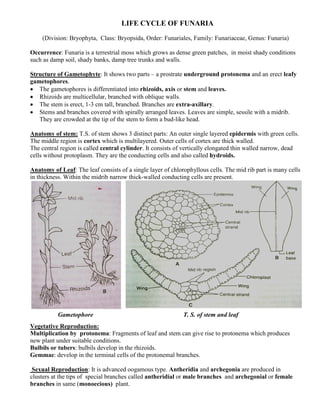
Life Cycle of the Moss Funaria
- 1. LIFE CYCLE OF FUNARIA (Division: Bryophyta, Class: Bryopsida, Order: Funariales, Family: Funariaceae, Genus: Funaria) Occurrence: Funaria is a terrestrial moss which grows as dense green patches, in moist shady conditions such as damp soil, shady banks, damp tree trunks and walls. Structure of Gametophyte: It shows two parts – a prostrate underground protonema and an erect leafy gametophores. • The gametophores is differentiated into rhizoids, axis or stem and leaves. • Rhizoids are multicellular, branched with oblique walls. • The stem is erect, 1-3 cm tall, branched. Branches are extra-axillary. • Stems and branches covered with spirally arranged leaves. Leaves are simple, sessile with a midrib. They are crowded at the tip of the stem to form a bud-like head. Anatomy of stem: T.S. of stem shows 3 distinct parts: An outer single layered epidermis with green cells. The middle region is cortex which is multilayered. Outer cells of cortex are thick walled. The central region is called central cylinder. It consists of vertically elongated thin walled narrow, dead cells without protoplasm. They are the conducting cells and also called hydroids. Anatomy of Leaf: The leaf consists of a single layer of chlorophyllous cells. The mid rib part is many cells in thickness. Within the midrib narrow thick-walled conducting cells are present. Gametophore T. S. of stem and leaf Vegetative Reproduction: Multiplication by protonema: Fragments of leaf and stem can give rise to protonema which produces new plant under suitable conditions. Bulbils or tubers: bulbils develop in the rhizoids. Gemmae: develop in the terminal cells of the protonemal branches. Sexual Reproduction: It is advanced oogamous type. Antheridia and archegonia are produced in clusters at the tips of special branches called antheridial or male branches and archegonial or female branches in same (monoecious) plant.
- 2. Structure of antheridial branch and antheridia: Antheridial branch or male flower is produced at the tip of the main stem of the gametophyte. It is surrounded by cluster of leaves called perigonial leaves. • Antheridia are arranged in clusters, intermixed with sterile multicellular hairs called paraphyses. Paraphyses are protective in function. • Mature antheridia are club shaped with a long, multicellular stalk and a globular body. • The body is covered with a single layered jacket which surrounds numerous androgonial cells. • The androgonial cells develop into antherozoids or sperms. • Each sperm is spirally coiled, elongated structure with a pair of flagella. Mature sperms are released from the antheridium by the separation of the jacket cells. Structure of archegonial branch and archegonia: The archegonial branches develop from the base of the male branches. They are covered with large leaves called perichaetial leaves. Cluster of archegonia are found at the tip of the each branch. • The mature archegonium is flask shaped with a basal multicellular stalk, long twisted neck and a swollen venter. • The neck is covered with 6 vertical rows of neck cells and cover cells. It encloses more than 10 neck canal cells. • The venter is covered by 2-3 layers of cells. It encloses a venter canal cell and a basal egg cell.Intermixed with the archegonia, long hair-like, multicellular paraphyses are present. Structure of Sporophyte: The sporophyte is seen at the apex of the archegonial or female branch. A mature sporophyte shows three distinct parts – the foot, seta and capsule. • The foot is a small conical structure embedded in the female tissue. It helps in attaching the sporophyte to the gametophyte and absorption of nutrients from it.
- 3. • Seta is a long, slender and twisted structure. It carries the capsule at its tip. • The capsule is the fertile structure of the sporophyte. In an L.S., it shows three distinct regions – the apophysis, theca and operculum or lid. • Apophysis is the basal green, photosynthetic part of capsule. It has a central strand of conducting tissue. • The theca is the urn shaped fertile, middle part of the capsule. It has a central strand of tissue called columella which is cone shaped. • Surrounding the columella is the spore sac. It is covered by outer spore sac wall which is 3-4 layers in thickness. The inner wall is just one cell thick. Spore sac consists of diploid archesporial cells which after meiosis develops into haploid spores. • Outer to the spore sac is an air space consisting of many air cavities. These cavities are traversed by cells called trabeculae. • Outside the air space is the capsule wall which is many layers thick. The outer layer is the epidermis. Inner to the epidermis is the two layered hypodermis of colourless cells. Within the hypodermis is the spongy layers of green cells. • Operculum is the terminal lid-like portion of the capsule. It is 4-5 layers thick. Inner to the operculum is a structure called peristome. It consists of two sets of curved teeth like structures, lying one above the other. Each set has 16 teeth. The outer peristomal teeth are hygroscopic and help in the dehiscence of the capsule and dispersal of spores. • When capsule is mature, it dries up, the operculum is blown up. Spores are discharged by the hygroscopic movement of peristome teeth. Germination of the spores: During favorable conditions, spores germinate to form a multicellular, filamentous, branched structure called protonema. It consists of green prostrate branches called chloronemal branches and colourless branches called rhizoidal branches. Green Bud like structures develop on the chloronemal branches which then grow and develop into the leafy gametophores. ©Dr. Jayakara Bhandary M. SGL in Botany, GAS College, Karwar-581301
